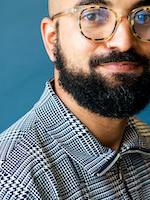

Creating STEAM Student-Led Learning Experiences Rooted in Freedom, Justice and Identity |
Participate and share : Poster
jacob adams Thomas Figueroa Sheryl Quock Rafaela Tapia
This experiential learning experience provides educators with the opportunity to create STEAM student-led learning experiences that are rooted in justice and freedom. Participants will work in groups and use case studies to work through and learn how to support youth as they build power in their communities.
| Audience: | Coaches, Curriculum/district specialists, Teachers |
| Skill level: | Beginner |
| Attendee devices: | Devices not needed |
| Topic: | Instructional design & delivery |
| Grade level: | PK-5 |
| Subject area: | Computer science, STEM/STEAM |
| ISTE Standards: | For Students: Knowledge Constructor
|
Educators will leave this workshop with new core principles, skills, and connections that inspire and motivate them to trust in and support their elementary and middle school students as they build power in their communities.
Educators will leave this workshop with a deeper understanding of the following core principles: student-led not just student leadership, sense of community, and radical visions setting. As the STEM to the Future team has implemented and refined our programs we have found the aforementioned principles to be vital in creating spaces that are truly liberatory, student-led, and appropriate emerging technologies.
Lastly, educators will leave this workshop with a digital toolkit that includes several power building lesson plans. For example, they will receive a lesson that teaches students how to “freedom dream.” Additionally, they will receive resources that assist them in identifying community partners, surveys they can use to identify their students’ passions, a project plan they can use to build out their program and access to a digital community (slack channel, whatsapp, or another medium the group decides) to share successes and reach out for support.
Time has long passed for Black and Latinx elementary youth to be seen as scientists, designers, community planners, and activists. The opportunity for them to be seen as such is rare and when it is afforded to Black and Latinx youth, it is almost exclusively for high school youth.At STEM to the Future, we start this process with elementary and middle school youth showing them that age isn’t a prerequisite for creating change. This experiential learning experience provides 2nd-12th grade educators with the opportunity to create STEAM student-led learning experiences that are rooted in justice and freedom.
Breakdown
Introduction to Facilitators and STEM to the Future (5 minutes)
During this section members of the STTF team will briefly introduce themselves and build connections with participants and conduct a poll to get a better gauge of who is in the room and what they want from this session. We will conclude this section with a quick overview of our organization and how we are supporting youth as they build power in their communities.
Why Student-Led Learning Experiences and Why Now? (15 minutes)
During this section we will set the stage for why it is important that society reframe what education looks like and why the youth must play a part in actively imagining and creating a world that doesn’t exist yet. We will also cover core principles that we believe are vital to creating liberatory student led learning experiences.
Case Study Overview (10 minutes)
During this section we will lay out the contents of the case study and ensure all participants are clear on the goals and outcomes of the work time.
Group Work Time (40 minutes)
Participants will be given case studies that include student interests, neighborhood data, community organizations and quotes from members of the community. With the support of the STTF team, participants will work in groups and use these case-studies to decide how they will support their students in building power in their communities. For example, a group may receive a case study in which their students decided to start an urban farm to bring food justice to their community. The group will use the assets and data found in the case studies to decide which community organizations to partner with, how they’ll partner with community organizations, how to include the various interests of the students such as graphic design and photography, and equally important, ensure that the students’ project meets the needs of their community. At the end of this section, groups will have a project plan that identifies how they will include their students’ interests, which community organizations they decided to partner with, and a list of first steps they need to take when they get home to create this opportunity for their students or teachers.
Group Presentations (15 minutes)
During this section each group will present their project plans, explain why they made their decisions, and what they did to ensure they project is actually student led.
Wrap-Up Q&A (5 minutes)
We will wrap up with a brief survey and answer any questions.
Pedagogy of the Oppressed- Paulo Friere
Teaching to Transgress -bell hooks
Appropriating Technology Vernacular Science and Social Power- Ron Eglash, Jennifer L. Croissant, Giovanna Di Chiro, and Rayvon Fouché
Cultivating Genius- Gholdy Muhammad
Understanding the Buddha’s Teachings- Thich Nhat Han
Freedom Dreams- Robin D.G. Kelly

jacob is the Founder and Executive Director of STEM to the Future. Prior to founding STTF, jacob was a Teach For America teacher in New York City where he was an elementary school educator in Brooklyn and Harlem. He moved to Los Angeles to be an instructional coach at TFA. Jacob has 8+ years of experience in education and is using that experience to help students be solution-oriented individuals who use their gifts to uplift the community.He’s a 4.0 School Essentials and Tiny Fellow. He’s also a photographer and co-host of the Make it Make Sense (MIMS) Pod.


Sheryl is the Director of Programs at STEM to the Future and organizes with various community groups in the Los Angeles area.
